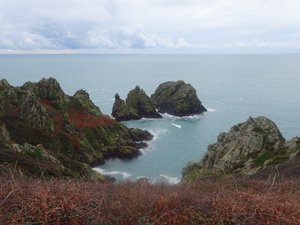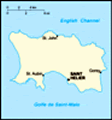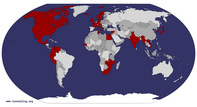Advertisement
Published: January 11th 2020

 Pea Stacks
Pea Stacks
Jerbourg Point, GuernseyDear All
Greetings again! I believe I last left off having just arrived back from the stark island of Sark, after an amazing two days of rural, island explorations. My third day of my trip was my first full day of explorations this time on the comparatively much larger island of Guernsey. I had two full days, and decided to split the island in two – on my first day I’d explore the south and west, and on the second day, the north and east – simple! It was a small enough island anyway, and at only 25 square miles, is almost half the size of its Channel Island neighbour, Jersey. There was plenty of time to explore this small, triangular-shaped island.
Unfortunately most of the tourist sights were closed during the winter season, including the spectacularly sited Castle Cornet jutting out into the sea from St Peter Port, along with the German Underground Hospital and the Victor Hugo house, both also in town. After a bit of research, I decided to target a couple of places that were open, but mainly spend time exploring the natural beauty of the island – there is certainly plenty of it.

 Coastal View
Coastal View
Rocquaine Bay, GuernseySo on full day one, I took a bus out of town again, towards the airport, but got off about two miles before it for my first port-of-call that day, the Sausmarez Manor. Different to the Saumarez Park in the north of the island, more on that in my next one, the Sausmarez Manor is a beautiful old manor house, home to the Sausmarez family, and the current Seigneur of the island, Peter de Sausmarez, since 1714, although the family have lived on the site since 1254. The manor itself was closed, no surprise there, but the gardens and park surrounding the building itself were open, and I enjoyed a wander through its subtropical gardens, and a stumbling upon a coppersmith’s workshop. This place was in fact open, and I had a good chat (or at least, I listened, he chatted) with the coppersmith working there, evidently making copper souvenirs over the winter period in time for the upcoming summer tourist season. He mentioned I was the first visitor in two weeks, and I enjoyed the quirkiness of the place, before I bade farewell and continued my journey.
From Sausmarez Manor I headed southwards, towards the stunning Jerbourg Point

 Blue Post Box
Blue Post Box
Jerbourg Point, Guernseypeninsula, one of the most scenic coastal spots on the island, and I wasn’t disappointed. After refuelling with a latte at the Hotel Jerbourg, I headed to the southern tip of the peninsula, casting a stunning gaze over the rocky outcrops all around, and back inwards to the west over the splendid Moulin Huet Bay. I spent time contemplating the beauty whilst sat on one of the numerous World War II observation blocks built all around the Guernsey coastline, imagining what life must have been like in the two-room facility for the German soldiers stationed there during the Nazi Channel Island occupation. The concrete, straight-lined monolithic block was in stark contrast to the natural beauty all around. A particular highlight were the famous Pea Stacks, or Les Tas de Pois d’Amont, heading out from the southernmost point of the peninsula, and said to resemble three hooded monks. I couldn’t quite make them out, but was intrigued by the story of the middle stack being called Le Petit Bonhomme d’Andriou, named after a local pagan priest who upon witnessing a ship heading for disaster on the rocks and having prayed to no avail to his pagan gods, prayed instead to the
Christian God, vowing that he would convert to Christianity if the ship was saved. The ship was indeed saved, and Andriou was subsequently baptised and built a chapel on the site.
My walk took me all around the beautiful Moulin Huet Bay, along cliff paths, up and down through gorse bushes with the sound of waves crashing in the distance down below, as far as a viewing point also appreciated by 19
th century French impressionist Pierre-August Renoir, from where he painted a work called “Baie de Moulin Huet a travers les Arbres”, or “Moulin Huet Bay through the Trees”. From here I took a steep, wet path called Water Lane, running beside a babbling brook, and back to the main road again at a tiny hamlet called St Martin. My destination here was the tiny St Martin’s Parish Church, not so much for the church itself, but for a famed resident just outside its cemetery. For just outside the church grounds, I imagined positioned there away from the hallowed ground of the Christian cemetery, stood Guernsey’s most famous piece of prehistory, “La Gran’mere de Chimquiere”, or “The Grandmother of the Cemetery”. This is a menhir, a carved piece of
rock, created around 4000 years ago, bearing the distinct outline of a female image. I found this fascinating, particularly as I had never seen an actual menhir before, despite being a huge fan of Asterix, and his menhir-wielding friend Obelix, and also because despite its pagan origins, it still stands there in front of the Christian church, where locals apparently decorate it with flowers and wreaths, particularly during weddings and other Christian celebrations. The menhir has a notable crack through its middle, apparently created by an angry church warden unhappy about the presence of idolatry near the church. I found the piece of stone fascinating.
From here, I hightailed it back to the main road, just in time to catch my next bus, which was to take me all the way to the westernmost point of the island, Rocquaine Bay, to its northern tip at another tiny hamlet called L’Eree. Here I enjoyed a picnic lunch in the grounds of a hotel seemingly closed for the winter, before heading up to L’Eree Headland in the distance. There were numerous sites of interest here. I began by heading to the small sea channel separating the headland from tiny Lihou Island.
Lihou Island is a mere 38 acres, and most of the time is an island, except for around four hours a day in which low tide reveals a causeway joining it to mainland Guernsey. I had done some prior research, and noted that the causeway was “closed” during my visit, having had its last day of opening the day before, and re-opening again in five days, as also said a sign at the entrance to the causeway. I found this particularly disappointing, as at just about my time of arrival, around 2.30pm, the tide was in fact receding and revealing the causeway link to the island beneath, just to tempt me! It would be visitable for two hours, and I contemplated crossing it anyway, as although it was “closed” there was actually no barrier or seemingly anything stopping me. On the island itself lie the ruins of St Mary’s Priory, operating between its construction in the 11
th century and its abandonment in the 16
th century. I have a particular fascination for such remote monasteries, intrigued by the idea of religious people living out a monastic life completely at one with nature. Lihou is also home to the famous “Venus Pool”,
a small, swimmable tidal pool left behind at low tide. Despite the temptation, I decided not to head across the causeway, not least because there was an imposing building directly on the other side of the causeway, whereby I envisaged some authoritative type ready to seize and arrest me for trespassing. I also couldn’t imagine what it would be like if I became stuck there by the rising tide again, having to wait on the island until the following morning.
Instead, after taking a few photos, I headed back inland to explore more of the L’Eree Headland. This included firstly Fort Saumarez, a dramatic, imposing several-storeyed tower built again by the Germans during World War II as a lookout and armoury. There was a sign upon entering the grounds of the fort saying that visitors do so at their own risk, due to the area being formerly militarised. This notice I did ignore having just seen a local walking his dog through the grounds in the opposite direction, and found myself amazed at being able to walk along German trenches built at the foot of the tower, and German military fortifications, dating back to the Second World War, and
still being on British soil! The Channel Islands were in fact the only part of the British Isles to have succumbed to the Germans, mainly due to their abandonment by the British at their being too difficult to defend due to their proximity to France. The Germans on the other hand saw them as the perfect base from which to plan their never-realised ambition of invading the British mainland. As a result, the Channel Islands are some of the most heavily militarised and fortified places in Europe. Fort Saumarez is just one of numerous bunkers, forts, gun emplacements and tunnels still intact and throughout the island today. Amazingly on the very evening I arrived home, I watched a fascinating episode of “Abandoned Engineering” on TV, dedicated to the military fortifications of Guernsey. They really are quite incredible, at once incongruent with the natural, pastoral beauty of Guernsey, but also at the same time almost naturally meant to be there. Perhaps this latter feeling of their belonging comes from my own memories of simply seeing pictures of the Channel Islands in my childhood, and always having associated them with concrete Nazi structures. I really did enjoy walking through the German-built trenches.

 Mini Railway
Mini Railway
Sausmarez Manor, GuernseyAfter this, I headed to my final site on the headland, Le Creux es Faies, or “The Fairy Cave”, Guernsey’s third largest dolmen and megalithic tomb. I will write more about these structures in my next one, as the next day I visited the island’s most intact dolmen, Le Dehus. It was a spooky place to be, knowing that several bodies were buried and entombed in such a structure thousands of years ago. Fascinating nonetheless.
From here, the sun was beginning to set, so I planned a coastal walk along the spectacular Rocquaine Bay. This is the island’s only west-facing bay, so it was a great place to walk and watch the sun go down over the western horizon, particularly with the tide out and the sun’s rays reflected dramatically off the mass expanse of wet sand in front of me. I walked most of the mile and a half along the beach itself, clambering over seaweed, rocks and rivulets, both because it was beautiful and fun, but also as the main road above had no pavement, as with many of the rural roads in Guernsey. I found this one of the most unnerving parts of my visit,

 Subtropical Gardens
Subtropical Gardens
Sausmarez Manor, Guernseyhaving to constantly be on the lookout for cars on the island, which was different to Jersey. Jersey felt much more rural and less trafficky, seemingly because there are more cars in Guernsey in proportion to its size, than Jersey. Whilst in Jersey there were many places I went without the constant buzz of traffic, I didn’t feel this to be the case in Guernsey, which made it feel more claustrophobic, and you always had to be on the lookout when walking the lanes. The beach walk was a great alternative, passing by the quite stark and sombre Fort Grey, home to the fascinating-sounding Shipwreck Museum, but of course at this time of year was closed, and on to my final destination of a bus stop in the village of Pleinmont in the southern corner of the bay. I noted in the post-dusk darkness from the timetable at the stop that the next bus was in an hour’s time – perfect, as there were the cheery lights of a hotel bar in the distance beckoning me onwards to finish off the day with a draught of local beer. I happied away this hour in a cosy old-school pub atmosphere, in

 Local Sales
Local Sales
Jerbourg Point, Guernseya dark remote part of the island, contemplating wonderfully the day I had just had exploring the south and west parts of the island.
Even better news was the fact that the bus would take me on a winding bus route through the interior of the island and deposit me right outside my hotel, meaning there was no hard walk up the hill from the Town Terminus to look forward to this time. Dinner involved a delicious Spaghetti Bolognese, and I had decided during the day to request a room upgrade to a double room rather than a single room. For £15 more a night, I was treated to a huge room, in a tucked away, quiet corner of the hotel, with a large double bed, and no staircase by the wall by my single bed keeping me awake (as it had done the night before, as some heavy footsteps woke me up just after midnight…). I settled into a lovely evening, and a blissful night’s sleep, after two fitful ones before in awful room number 11. I was looking forward very much to exploring the other half of the island, the north and the east, the following day.

 Local Bird
Local Bird
Jerbourg Point, GuernseySo I will write about my final day in my next and final blog entry for this trip. Thank you for reading this one, and all the best to all.
Alex
Advertisement
Tot: 0.166s; Tpl: 0.016s; cc: 10; qc: 40; dbt: 0.0958s; 1; m:domysql w:travelblog (10.17.0.13); sld: 1;
; mem: 1.2mb






















D MJ Binkley
Dave and Merry Jo Binkley
Off Season travel
Sorry so many interesting sights were closed but sounds like you had a fantastic time anyway. Will you go back? I loved hearing about the coppersmith. I loved the history and hearing about the occupation. I'm also drawn to monasteries. I must say even the bus ride sounded nice. What a terrific trip.